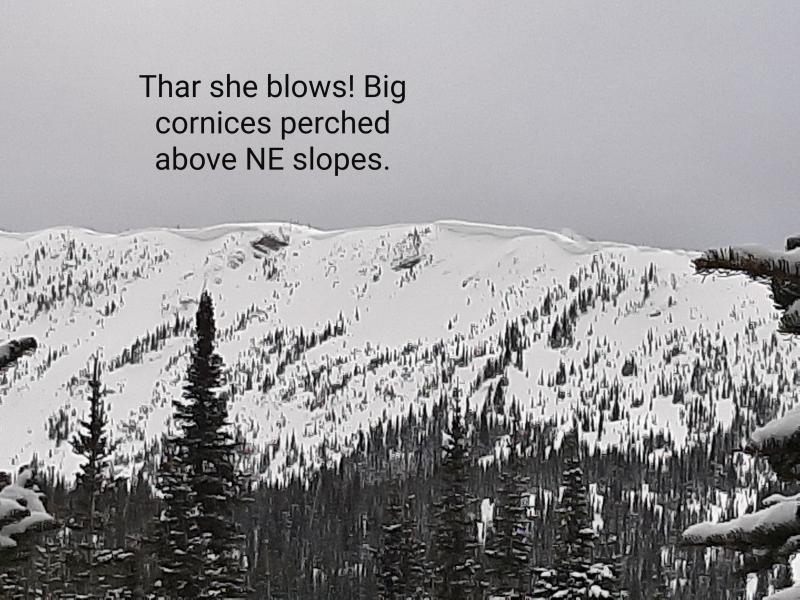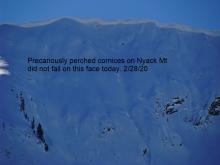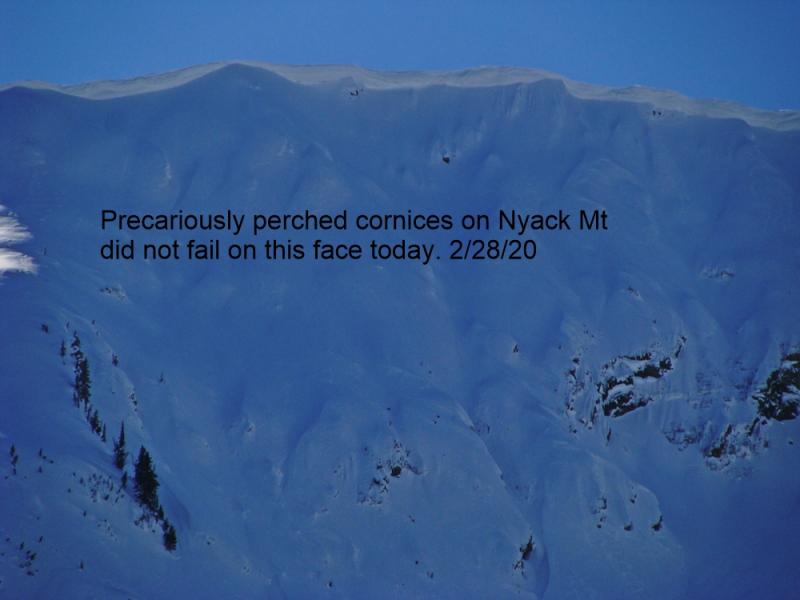| Monday | Monday Night | Tuesday | |
|---|---|---|---|
| Cloud Cover: | Showers | Light snow showers | Light to moderate snow showers |
| Temperatures: | 39-49 deg. F. | 22-30 deg. F. | 33-45 deg. F. |
| Wind Direction: | SW | SW | SE |
| Wind Speed: | 12-13 gusts 24-28 | 7-8 gusts 17-20 | 6-7 |
| Snowfall: | 0 in. | 0-2 in. | 2-8 in. |
| Snow Line: |
Whitefish Range
Swan Range
Flathead Range and Glacier National Park
How to read the forecast
The combination of weekend warming, a light refreeze of the surface snow and rain will provide us with another day of wet loose avalanche problems. The avalanche danger is MODERATE above 5000 feet. Human triggered avalanches are possible in the moist surface snow on all aspects. Recent warming weakened cornices and it is best to avoid them today. Weak snow near a series of crusts exists in the upper snowpack that should be assessed before committing to a slope.

2. Moderate
?
Above 6500 ft.
2. Moderate
?
5000-6500 ft.
1. Low
?
3500-5000 ft.
- 1. Low
- 2. Moderate
- 3. Considerable
- 4. High
- 5. Extreme
-
Type ?
-
Aspect/Elevation ?
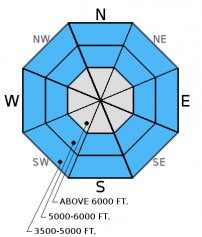
-
Likelihood ?CertainVery LikelyLikelyPossible
 Unlikely
Unlikely -
Size ?HistoricVery LargeLargeSmall

This weekends warm sunny weather produced a widespread wet loose avalanche cycle. Initially this involved only the sunny aspects but yesterday we received a report that wet loose slides were occurring on shaded aspects. The weather system that moved into our area this morning has brought rain to at least 6000 feet. On previously shaded aspects this rain will transform what remains of the relatively cool dry surface snow by adding moisture. On sunny aspects the rain will add moisture to the already saturated snow surface. Above freezing temperatures, along with light rain, will create a wet loose avalanche problem on steep slopes involving all aspects at mid and lower elevations. If you are creating roller ball/pinwheel activity while riding or skiing on a slope it is time to move to a different aspect or terrain with less slope angle. The consequence of even a small, loose avalanches can be amplified if you are caught in or around a terrain trap like a narrow gully, cliff band, or in the trees.
-
Type ?
-
Aspect/Elevation ?
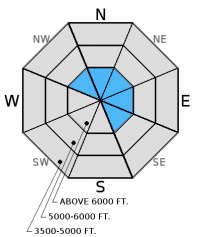
-
Likelihood ?CertainVery LikelyLikelyPossible
 Unlikely
Unlikely -
Size ?HistoricVery LargeLargeSmall

The recent warm weather, combined with today's rain, has helped to weaken cornices throughout our area. Late season snowpack conditions usually entail large cornices and this season is no different as we have recently observed some impressive cornices across the area. With a weak refreeze at upper elevations overnight, along with a bit of rain, cornice fall will continue to be a problem today. The huge amount of stress a falling cornice puts on the snowpack can trigger deeper weak layers like lingering windslabs or weak snow around the late February crust. Skiers near Mt. Grant observed cornice fall and subsequent slab avalanches Saturday. Cornices can release farther behind the ridgeline than expected so it is important to keep a safe distance when traveling above them and limit your exposure time when traveling below.
As we progress into a spring snowpack glide crack formation and failure will become more prevalent. A recent glide crack avalanche was reported in the Flathead Range over the weekend (image). Due to their unpredictable nature it is best to avoid all slopes with glide cracks on them.
-
Type ?
-
Aspect/Elevation ?

-
Likelihood ?CertainVery LikelyLikelyPossible
 Unlikely
Unlikely -
Size ?HistoricVery LargeLargeSmall

It remains important to evaluate the upper snowpack for weak snow around the series of crusts that are 1.5-3 feet from the surface, and assess the reactivity with stability tests. While we have not had recent reports of avalanches releasing on these weak layers, stability tests in most locations show they still have the potential to break across a slope (video1, video2). Where you find weak, faceted snow around these crusts it is important to choose appropriate terrain as it is possible to trigger an avalalanche. Put the odds in your favor by avoiding steep, convex roll-overs, and rocky terrain where the snowpack is notoriously shallow.
*Note correction in details of avalanche reported on Friday (3/18) on Peak 6996, see avalanche observation.
Sunday: Skiers in Canyon Creek in the southern Whitefish Range reported multiple wet loose slides in the Skook Chutes (Seven Sisters) that had occurred on Saturday. A party of skiers in Rescue Creek in the Flathead Range noted wet loose slides that occurred on sunny aspects Saturday. They also reported seeing wet loose activity initiate on northeast aspects in the late morning.
Saturday: Skiers in the Mount Grant vicinity in the Flathead Range reported wind slab, glide, and wet loose, natural avalanches that occurred yesterday (observation). They noted that no crusts existed in the upper snowpack above 7000 feet, and observed large surface hoar crystals on the surface. Interestingly, a glide crack failed on smooth rock slabs that triggered a shallower slab (image). Another party of skiers in the Skiumah Drainage observed natural avalanche activity on north and northwest aspects on Mt. Penrose. Mark and I were in Canyon Creek in the southern Whitefish Range. On shaded aspects we found 14 inches of low density snow on top of a supportable crust. We found buried surface hoar 2-3 feet from the surface that in some areas was well preserved, and in othe areas was decomposing (observation). Skiers on Elk Mountain in southern Glacier Park observed strong wind transporting snow along high ridgelines. They also noted a wet snow surface, deep boot penetration, and roller balls forming on sunny aspects.
Friday: Skiers on Peak 6996 near Marias Pass in the Flathead Range unintentionally broke two large blocks of cornice and were subsequently caught in a small soft slab avalanche. The cornice triggered an avalanche that propagated 40-60 feet across the slope and ran about 400 feet. One skier was caught and reported that they "got a little beat up" (observation). Skiers on Essex Mountain in the Flathead Range found the late February crust 2 feet from the surface with small, facets above. They also noted another round of surface hoar forming on the surface (observation). Snowmobilers in Kimmerly Basin in the Whitefish Range noted glide cracks opening on sunny slopes. Snow bikers in the Lost Johnny/Strawberry Lake area in the Swan Range found excellent riding conditions. The snow surface softened as the day progressed and they observed small, loose, wet avalanches in the upper elevation terrain (observation).
Visit our Observations page and our You Tube channel for more observations from the entire season.
Thanks to everyone for submitting observations. They are extremely useful and could help save lives.
HOW TO SUBMIT OBSERVATIONS:
Email: [email protected]
Call and leave a message: 406.387.3821
You can also submit quick observations via text: 406.241.4571 (FAC mobile)
OR
Submit Snowpack Observations: http://www.flatheadavalanche.org/node/add/snowobs
Submit Avalanche Observations: http://www.flatheadavalanche.org/node/add/avyobs
Yesterday was WARM! Despite high thin clouds, temperatures soared with most upper elevation stations reporting upper 40s to low 50s. Currently, mountain temperatures are 30º-35º F with winds out of the southwest at 7-19 mph with gusts from 11-27 mph. This morning light showers entered our area bringing up to 0.20 inches of water and 0-1 inches of snow. Temperatures at upper elevations are starting to cool a bit and showers should decrease throughout the day. Tomorrow will be feast or famine depending on the tracking of a wet storm system entering the Northern Rockies.
| 0600 temperature: | 30-36 deg. F. |
| Max. temperature in the last 24 hours: | 44-52 deg. F. |
| Average wind direction during the last 24 hours: | SW |
| Average wind speed during the last 24 hours: | 5-15 mph |
| Maximum wind gust in the last 24 hours: | 23-34 mph |
| New snowfall in the last 24 hours: | 0-1 inches |
| Total snow depth: | 79-105 inches |
This advisory applies only to backcountry areas outside established ski area boundaries. This advisory describes general avalanche conditions and local variations always occur. This advisory expires at midnight on the posted day unless otherwise noted. The information in this advisory is provided by the USDA Forest Service who is solely responsible for its content.













